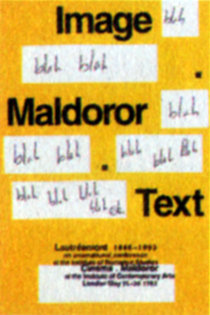Public Notice
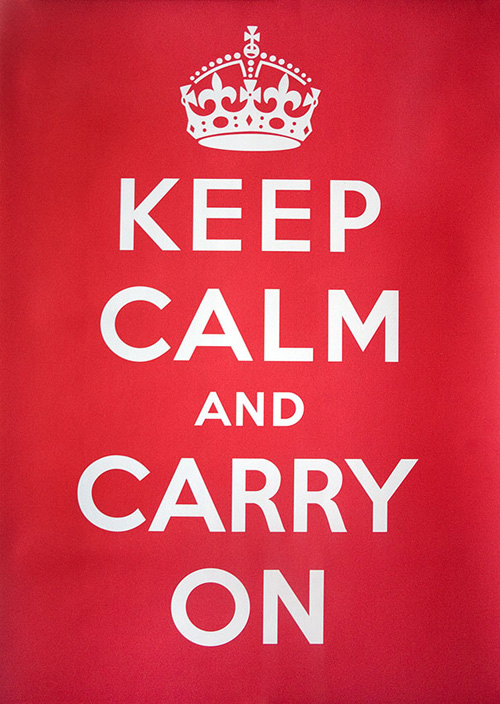
Above: Ministry of Information poster, made but not distributed in 1939, later rediscovered by Stuart Manley of Barter Books.
In her seminal 1970 essay on posters, Susan Sontag begins by making a distinction between the poster and the public notice. “Posters are simply not public notices,” she writes. “Both posters and public notices address the person not as an individual, but as an unidentified member of the body politic. But the poster, as distinct from the public notice, presupposes the modern concept of the public — in which the members of a society are defined primarily as spectators or consumers. A public notice aims to inform or command. A poster aims to seduce, to exhort, to sell, to educate, to convince, to appeal.” There are many tools in the poster designer’s arsenal to create the appeal Sontag describes, and the very rise of the poster as a form is tied to the rise of a technology needed to produce this appeal: color lithography. Implicit in Sontag’s argument, though, is a claim about the form of information itself. The information the public notice offers arrives pure, unvarnished, unadorned. The information the poster offers is designed, decorated, expressed. One’s form is neutral and the other’s is inflected. But is information ever formless? Can it ever be delivered without some influence from its carrier?
The public notice as an object presents us with a challenge: Where does seeing stop and reading start? Where does information end and design begin? As we witness the rise of a sober new Helvetica age, the public notice’s flat language and style shows up more and more in contemporary design. Here’s a look at some of that work, some earlier artistic predecessors, and some of the issues that arise from working with language as a medium in art and design.
In his 1973 book on The Public Notice, Maurice Rickards equates its development with a broadening need for authoritarian control: “Historically, [the public notice] represents an extension of the power of the ruler — authority mass-produced. In large measure it has retained this role to the present day.” Rickards explains that the printed form of these notices evolved methodically. Early commands, like those of Xerxes, King of Persia, were spread throughout the country via “shouting chains” of soldiers. Even when the development of writing finally made it possible for longer and more detailed orders to be transcribed, most of the population was illiterate, so a town crier was needed to read the notice aloud before it was posted in the public square. Often it would be delivered to trumpets and fanfare. Rickards notes that through these ceremonies “the document came to be seen as a tangible contact with the very will and person of the ruler himself.” Some of the earliest printed public notices even camoflauged the fact of their mass production, as printers took pains to make it seem as if the ruler himself had written the document. Thus the public notice’s content was tied to the king’s very utterances; its arrival and posting was tantamount to his own arrival; its words were created seemingly by his own hand. The King was the Law, and now the Law was the Word.
Flipping through the excellent Forms of Inquiry catalogue a while ago, I stopped to reflect on Mevis & Van Deursen’s contribution, which appropriates rules sent out to teachers and students at the Gerrit Rietveld Academy each year for proper treatment of their historic building. It states:

Essentially, Mevis & Van Deursen have created a public notice that forbids its own posting. The act is not a futile one; it is surely a comment on the condition of having to work within a living monument and the creative struggles created as a result. But, aside from the language, Mevis & Van Deursen have appropriated something else: Conceptual artist Lawrence Weiner’s trademark use of Franklin Gothic Extra Condensed. They have also dropped a fourth rule from the original text to better echo Weiner’s statements, which so often come in threes. A well-known example:
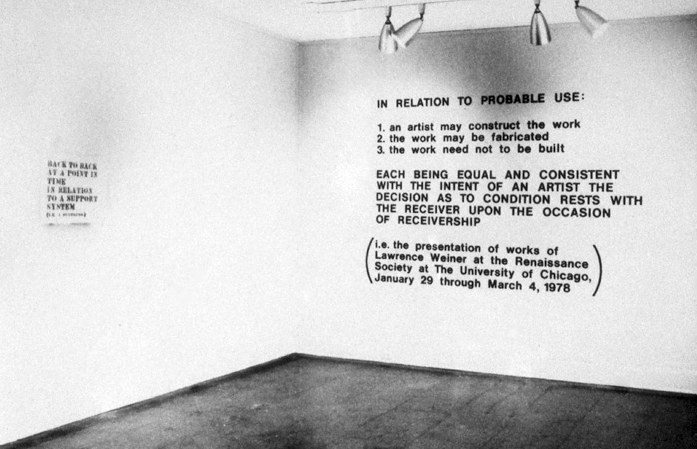
- THE ARTIST MAY CONSTRUCT THE WORK
- THE WORK MAY BE FABRICATED
- THE WORK NEED NOT BE BUILT
Weiner’s recent show at the Whitney, titled AS FAR AS THE EYE CAN SEE, was, perhaps, a signal of his importance to a growing group of artists and designers. Weiner’s ongoing interest in prepositions and directionals, which function in language almost as a kind of joint compound, seems to permeate the poster for the 2008 Yale MFA Graphic Design Thesis Exhibition which reads,
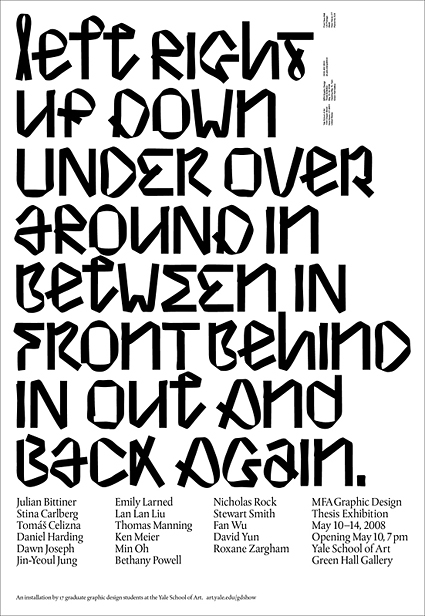
It’s one joint after another, making an almost circular loop of language. On the poster, this phrase is spelled out in Julian Bittiner’s ribbon-like Zigzag font, connecting the looped language with the loops of the hand in the act of writing. This design also connects with the actual construction of the MFA show itself, in which a large roll of plotter paper wound its way around the gallery, connecting one student’s work to the next via a continuous, floppy scroll.
When Weiner’s 1969 work A SERIES OF STAKES SET IN THE GROUND… was damaged, he realized that the work’s essence rested in its verbal formulation, not its physical implementation. Weiner began to see that his medium for sculpture could be language itself; that language alone was sufficient for communicating his ideas. The same year Weiner’s fellow artist Joseph Kosuth published his essay Art After Philosophy. Kosuth explains that “artness” is a criteria and that Duchamp’s strategy, employed with his Readymades, of simply declaring “This is a work of art” was enough to activate that criteria. Art could exist as a simple declaration or assignation, a public notice. The King’s Word. With this power, however, came responsibility: “Being an artist now,” Kosuth asserted, “means to question the nature of art.” So while artists were appropriating the power of the King’s Word, it was also their job to somehow investigate or undermine that power.
Weiner’s work began to do this via a verbal form of Duchamp’s Readymades, which curator Nancy Spector lists as “Readymade structures, such as idioms, clichés, and proverbs, which underscore the contingent nature of meaning when encountered in different contexts.” This is language this is reused so frequently we often fail to even hear it, and it becomes, in effect, “dumb” in both the simple and silent senses of the word. Weiner’s uninflected, workmanlike typography flattens out these phrases even further, leaving us with an ambiguous object: are we reading it or seeing it? Weiner’s work makes the tenuous boundary between seeing and reading physically real.
Many artists using language as a medium after Weiner start with these magically pervasive and authorless phrases. Christopher Wool is one, and his practice is interested, among many other things, in the mechanical application of paint to surfaces, in effect removing the artist’s hand and replacing it with other, more mechanistic marks like those of spraypaint cans, stencils, and photocopiers. His language follows suit, often running mechanistically along in lists like

a painting from 1988, in which that phrase — which comes from Coppola’s Apocalypse Now — is stenciled in black on white ground. Running in all caps with awkward breaks and traces of drips and smears, Wool’s painting jolts us into reading a phrase we’ve heard many times before in a new way. We struggle with it and are disturbed by it. Its logic is as coarse as its rough grid of letters. Its tone is as suffocating as its lack of white space. Its execution is not careful and considered, but hasty.
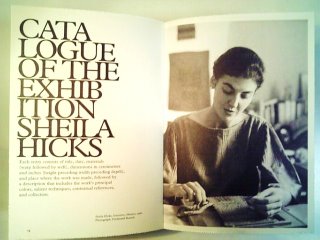
Irma Boom applies some of the roughness and tactility of Wool’s approach to wordspacing and irregular breaks in her headline settings for the book Shiela Hicks: Weaving As Metaphor.
The use irregular breaks and spacing to disjoint or disorient us and make us “see” language is also common in the work of artist Kay Rosen. The Krugeresque lowercase Futura Bold Oblique in a Rosen painting from 1987 shouts at us in red on black

but for all the doubling letters and breaking of words we cannot hear the warning until we look for the piece’s title: John Wilkes Booth.
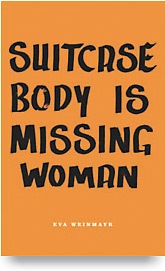
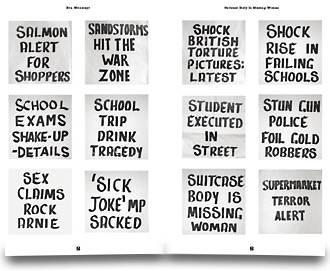
Rosen’s phrase is drawn from the news, which, in 2008, is probably the public notice’s most common content provider. (Kings now more often employ the press conference.) In 2005, artist Eva Weinmayr collected handbills from London’s Evening Standard newspaper for her book SUITCASE BODY IS MISSING WOMAN. Clunky, kooky, and almost always handwritten in all caps, the handbills replace the pomp and circumstance of royalty with the breezy informality of the paperboy shouting from a street corner at passersby.
The Evening Standard handbills reunify the public notice with the spoken language that originated it, though in a much less formal dialect. I can’t help be reminded of Weiner’s work again, and also of Jop van Bennekom’s wonderful deks for his BUTT magazine, which blend graphic bluntness with chatty description. A sample:
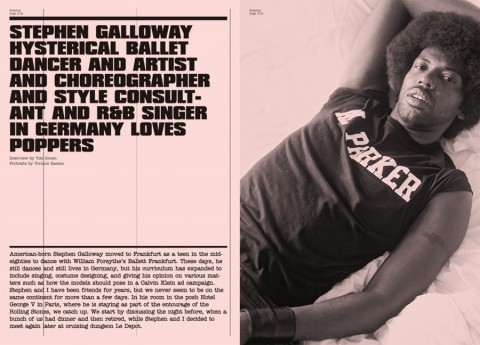
It’s all there: the run-on list, the bad break, the prepositional cement, the dumb syntax. In conversation with van Bennekom at the Walker Art Center, curator Andrew Blauvelt mentioned the headlines specifically, joking, “They’re very blunt but very effective; you don’t get them out of the normal copywriting schools.” Definitely not. This language comes from the street and from IM chat rooms, it comes from Conceputal art and vernacular signage, from punk flyers and concrete poems. It’s bad English but it’s bold English. Writ large, set tight, almost always capped in a dry, standard typeface available, these artistic decendants of the public notice use banality to be seen and boldness to be read. They slow you down, disrupt you, make you feel the weight of letters and the percussive sounds of speech. Language is a medium made of sounds but also of shapes. We bend it, break it, use it to authorize or to subvert. These explorations by artists and designers play with what language does, how it works, and how it relates us to one another.
This article was commissioned by Eye Magazine and published, in a slightly condensed form, in Eye 73. I had fun gathering visual research for this project, so I thought I’d share a few more of the pieces I wasn’t able to work into the piece below. — RG

Above: A comedy of errors, 169 bits by Ed Ruscha in type by Karl Nawrot, typeset by Scott Ponik.

Above: Album cover for Jackie McLean’s “It’s Time,” designed by Reid Miles for Blue Note Records.
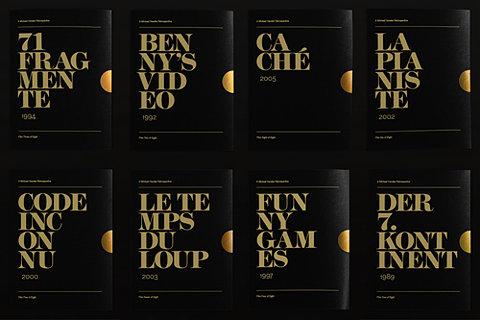
Above: “Now, You Can Let Go,” materials for a Michael Haneke film retrospective, designed by Nikolay Saveliev.

Above: American Apparel Cities Bag, photographed by Edwin Lee, Toronto, 2007. Posted to Flickr.

Above: Public sign, York Railway Museum, cited by Maurice Ricards in The Public Notice, and photographed by Neil T. Posted to Flickr.
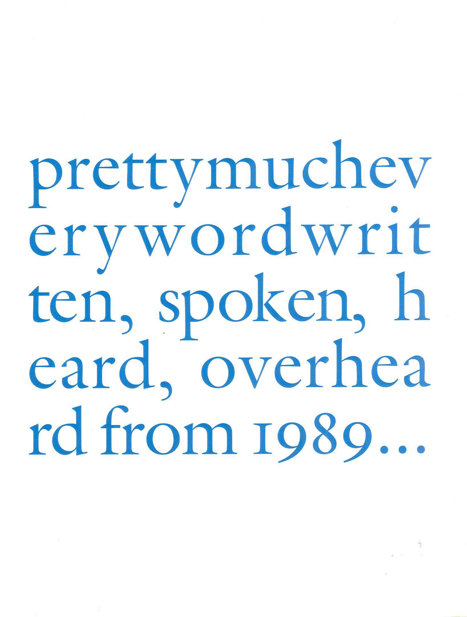
Above: Douglas Gordon, pretty much every word written, spoken, heard, overheard, from 1989… (2006). Installation view.
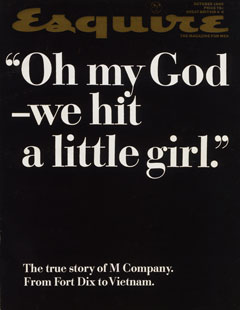
Above: Esquire cover, October 1966, designed by George Lois.

Above: Richard Prince, “I knew a guy who was so rich he could ski uphill…” More on Prince’s joke paintings.
